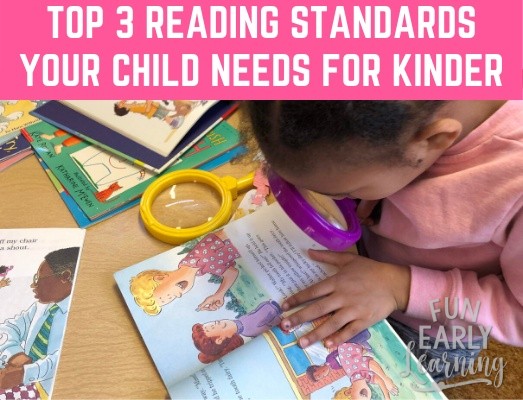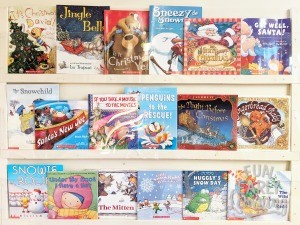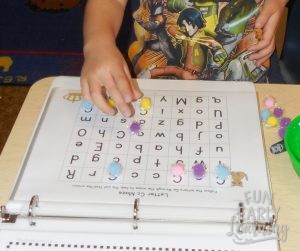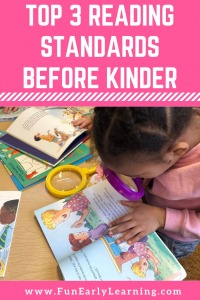
Children who understand and apply the top 3 Pre-K Reading Standards are prepared to succeed in kindergarten. We’ll walk you through how to assess if your child is ready and how to develop those skills. AND you can make it FUN! Get ready!
Literacy is the foundation for creating well-educated, successful people. Therefore it is crucial to develop a child’s literacy skills early on to help ensure that they are ready to learn upon entering kindergarten.

Did you miss part 1 of this series? No worries! You can read it here.
Why do Pre-K Reading Standards Matters?
I’m sure that you don’t want to see your child struggle in school, get frustrated and hate learning. Children who enter kindergarten with a LOVE for learning and an understanding of the top 3 Pre-K Reading Standards are prepared to read, write, and join in on learning.
Here are the top 3 reading standards and how to assess them
1. Reading Process: key ideas and details, concepts of print, and comprehension strategies
- How to Assess: When you read to your child, can they pick out key ideas and details within the story? Are they able to talk about the setting, characters, and sequence of events? Can your child use memory recall comparing the story you’re currently reading to other stories you have read? Can they compare stories to experiences they have had?
- Develop:
- Give your child access to age-appropriate books that they can get out and read independently and with you. Ask questions while you read. “What did David decide to throw in the house?” “Why are they going on vacation?” “Can you tell me the character’s names and something about them?”
- After you have read a book, have your child draw a picture about the story.

2. Foundational Skills: print concepts: demonstrates the understanding of basic features of print
- How to Assess: Does your child know how to properly hold a book and turn the pages? Do they understand that we read from top to bottom and left to right? Can they recognize and identify upper- and lowercase letters? Can they tell the difference between print and pictures, predict what will happen next in a story, or look at pictures and say what they think is happening in the story?
- Develop:
- Make sure your child has access to age-appropriate children’s books that they can get out whenever they want. Read to your child every day and show them how to properly hold the book and read each page. Ask questions while you read, such as “What do you think will happen next?” “Why do you think David was throwing the ball in the house?”
- Recreate experiences from books you read for your child to play with. If you read a story about a child going to the doctors, set up a play doctor’s office for your child. Have it include words, signs, and symbols that you would find at a regular doctor’s office – receptionist sign, waiting room sign, magazines, doctor’s name tag, prescription pads, etc.
- Play games and activities that promote letter identification – hide letters around the room or in a sensory bin and have your child go on an alphabet hunt, complete alphabet letter mazes using stickers, or decorate letters with art supplies.

3. Phonological Awareness: demonstrates the understanding of spoken words, syllables, and sounds (phonemes)
- Assess: Can your child identify rhyming words when you say them? Can they make rhyming words up on their own? Can your child recognize and name letter sounds? If you say a word, can they identify the beginning sound?
- Develop: Phonemic awareness is the building block for understanding language. It prepares the brain for reading and spelling. Here’s what you can do to help your child notice and manipulate sounds in speech for successful reading development:
- Play rhyming games with your child. You could say, “What rhymes with hat?” You could also have pictures of different objects and hold up each one to see who can make a rhyme with it the fastest.
- Read stories together that have a rhyming scheme, such as Come Rhyme With Me!, Rhyming Dust Bunnies, or Sheep in a Jeep.
- When writing with your child and they ask you how to spell something, sound out each individual letter and have them write down the letter they think corresponds to the sound. This will help build letter/sound correspondence.
By teaching your child these top 3 Pre-K Reading Standards, you give children tools they need to be SUCCESSFUL in kindergarten and beyond.
This article only covers a portion of assessment questions. We will provide (for free to our loyal followers!) our full assessment containing the list of skills children need for kindergarten at the end of the series of posts.
In our next article we’re going to talk about 2 Ways to Know if Your Child’s Writing Skills are Ready for Kindergarten.


